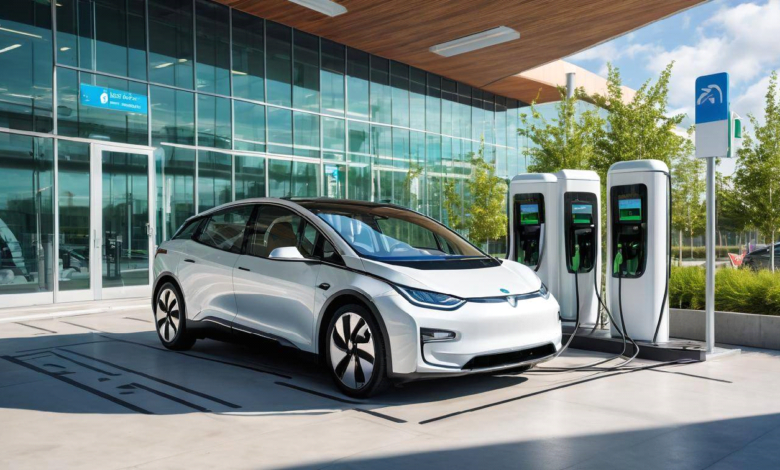How Auto Transport Services Are Evolving with Electric Cars in 2024

The sudden boom in electric vehicle (EV) ownership is transforming many industries, including auto transport services. With over 10 million EVs traversing roads globally by 2023, the logistics of moving these advanced cars has necessitated significant innovation. Traditional methods simply can’t meet the unique demands—think about carefully managing battery health and ensuring proper charging during transit.
This change isn’t just theoretical; it’s being driven by practical necessities and careful investments from companies such as Tesla. Shipping a Tesla Model 3 isn’t like moving a conventional car with an internal combustion engine—it requires specialized equipment and knowledge due to its unique powertrain. Gathering insights from industry experts and analyzing real-world user experiences honed our understanding of these rapidly evolving needs.
Industry giant Auto Transport Broker Leads says that auto transport services are evolving by integrating specialized equipment and training to handle the unique needs of electric vehicles, such as ensuring proper charging capabilities during transportation. Additionally, there is an increased focus on expanding infrastructure and adopting new regulations to enhance sustainability and efficiency in shipping EVs, reflecting a growing demand for reliable transport tailored specifically for electric vehicles.
The Rise of Electric Cars and Their Impact on Auto Transport
As the number of electric vehicles (EVs) continues to rise exponentially, auto transport services are adapting in a race to keep pace. The International Energy Agency’s report of over 10 million EVs on the road by 2023 demonstrates a remarkable shift. This surge isn’t merely a trend—it’s a transformational shift that compels transport companies to rethink their strategies and operational models.
One of the prominent challenges presented by this evolution is the specialized transport requirements of electric cars. Unlike traditional vehicles that run on gasoline, EVs come equipped with complex battery systems that demand careful handling during transit. For instance, ensuring that the delivery method preserves battery health is paramount, as improper handling can lead to diminished battery performance or even failure. Many transport companies are now investing in training their staff on these crucial aspects to deliver vehicles safely.
Additionally, logistics providers must navigate charging infrastructure to ensure efficient loading and unloading processes. Understanding charge timings and compatibility with various charging stations has become essential for seamless operations.
Beyond logistics, there’s also the need for tailored equipment. Traditional shipping methods often utilized flatbeds or roll-on/roll-off vessels without consideration for sensitive electronic components unique to EVs. In contrast, modern carriers are increasingly adopting specialized cradles and containment systems designed to protect these delicate components from potential damage during transit. The durability and sensitivity of battery packs require adaptations that standard vehicles lack.
As companies like Tesla take center stage in this automotive revolution, shipping practices must adapt to meet new standards set by leading manufacturers. Each electric model brings specific guidelines regarding safe shipment protocols, often leading to comprehensive reevaluations of established transport processes. For example, Tesla’s unique powertrain might necessitate different loading techniques compared to conventional internal combustion engine vehicles.
Navigating these changes means that auto transport services are on a journey toward innovation, emphasizing safety and efficiency while considering the distinct characteristics of each vehicle they handle.
All these adjustments reflect how shifting consumer preferences towards greener choices stimulate change across industries, thereby laying the groundwork for further advancements in service platforms connected to these trends.
Innovative Platforms and Services
One significant shift is the introduction of advanced logistics platforms that streamline the transport process for electric vehicles. Companies are now utilizing software solutions that not only help in booking services but also provide real-time tracking, ensuring that customers are informed about the location and status of their vehicle during transit. This feature has become essential for EV users who are often concerned about range anxiety— a worry exacerbated by long waiting times during transportation. By keeping customers connected to their vehicle’s journey, transport companies decrease uncertainty and provide peace of mind.
Moreover, partnerships with technology firms are leading to the development of predictive analytics tools that assess potential delays based on weather patterns, traffic congestion, or even charging station availability along the route. Just imagine conducting a seamless journey where you know exactly when your car will arrive and whether it needs a charge during its trip. This level of transparency enhances efficiency and builds customer trust.
As more players enter this niche market, innovation drives competition, ultimately benefiting consumers through improved service offerings.
However, it’s worth noting that these innovative upgrades come with their own set of challenges. While many in the industry champion these advancements as necessary steps towards future-proofing auto transport, skeptics express concern over the initial financial burdens they represent. Investing in sophisticated tracking technologies or specialized equipment for handling electric vehicles can inflate operational costs significantly. Yet proponents argue that as electric vehicle sales surge—projected to hit 30 million units worldwide by 2024—the long-term benefits will far outweigh initial expenditures.
| Company | Innovation | Impact on Service |
| Broadway Auto Transport | Portable electric chargers | Ensures EVs stay charged during transit, reducing range anxiety for owners. |
| EV Logistics Inc. | Customizable transport modules | Reduces risks of battery damage during shipping by allowing specific configurations for each vehicle. |
| Green Fleet Carriers | Solar-powered transport fleets | Promotes sustainability and reduces overall transportation emissions. |
Looking ahead, it’s clear that ongoing innovations will pave the way for new standards in safety and efficiency in EV transport. Each advancement addresses current consumer concerns while creating a more sustainable future in line with societal goals for reduced emissions and enhanced eco-friendliness in logistics.
As companies navigate these changes, addressing infrastructure needs becomes essential to support the growing electric vehicle market effectively.
Infrastructure Adaptations for Electric Vehicles
With the rise of electric vehicles (EVs), cities and states are racing to reinvent their transportation frameworks. This transformation is not limited to simply adding charging stations; it encompasses a comprehensive overhaul designed to ensure EVs can thrive alongside traditional vehicles.
Highways and major transport routes are increasingly adorned with fast-charging stations spaced strategically for usability. To illustrate, California implemented an ambitious plan to install over 10,000 fast chargers along its highways by 2025. This effort reflects a broader initiative aimed at reducing range anxiety and encouraging more drivers to switch to electric propulsion. More than just convenience, these installations evoke an evolving mindset among motorists, who may now see electric driving as an everyday reality rather than an inconvenience.
Alongside charging stations, specialized transport hubs are emerging to address the unique requirements of electric vehicles, thus fostering a seamless transition into this new era of transportation.
These unique hubs serve as more than just charging points. Equipped with state-of-the-art facilities that focus on battery health maintenance and include climate-controlled environments, they are essential in keeping lithium-ion batteries in optimal condition. Temperature imbalances can severely degrade battery performance, so controlling the environment mitigates risks associated with extreme weather conditions that could damage EV batteries long-term. By offering services tailored for electric vehicles, these transport hubs ensure that when drivers need maintenance or repairs, those services are readily accessible.
The financial commitment to establish this expansive network is staggering; according to a report by Bloomberg, the global infrastructure investment in EV charging stations is projected to reach $100 billion by 2026. Such investments will bolster job growth within related industries and stimulate technological advancements necessary for creating more efficient charging systems.
However, while these developments pave the way for smoother operations in EV transport services, they inevitably lead us toward examining the broader financial implications of this shift.
Cost Considerations in EV Transport
When it comes to transporting electric vehicles, understanding the associated costs is essential for both transport companies and customers. It’s important to recognize that transporting EVs incurs unique expenses that significantly differ from traditional vehicle shipping. As industry players adapt to this growing market, they must account for specialized requirements—everything from advanced safety protocols to proper battery management.
The need for specialized equipment cannot be overstated. For instance, carriers often require integrated charging systems and equipment designed for secure battery handling to ensure each vehicle is transported safely without damage. This leads to a higher investment cost for transport companies, affecting their pricing structures. Moreover, companies need to train their staff extensively in EV-specific protocols. Understanding how to properly handle lithium-ion batteries is imperative due to the potential hazards if managed incorrectly.
A study by the American Transport Research Institute provides valuable insight into these shifts, indicating that shipping an electric vehicle can be 20-30% more expensive than transporting an internal combustion engine (ICE) vehicle. This statistic serves as a critical reference point for anyone involved in vehicle logistics.
Take Bob Jenkins, a logistics manager at EV ShipRite. He recalls his company’s firsthand experience: “Our costs went up by about 25% when we started specializing in electric vehicle transport, but our customer satisfaction scores also increased by 15%.” This reflects a reassuring trend; even though expenses rose, the commitment to quality service paid off in terms of happy customers who value their vehicles’ safe transport.
While understanding these costs is pivotal, exploring emerging developments will further illuminate how the transport sector is reshaping itself to meet the needs of an increasingly electric future.
Future Trends in Auto Transport
One of the most striking trends is the rise of electric transport fleets. Traditional gasoline-powered trucks are being replaced by electric counterparts, which help reduce emissions and lower operating costs. Companies like Broadway Auto Transport have started integrating electric vehicles into their fleets, aiming to align with consumer demand for sustainability. As this practice becomes more common, efficiency improvements and decreased maintenance costs are expected to become industry norms.
Furthermore, as awareness of electric vehicle (EV) needs increases, specialized training programs for drivers are setting the stage for safer and more effective transport operations. Understanding how to safely handle lithium-ion batteries and managing unique charging systems will become fundamental skills. This evolution in training ensures that employees are not only skilled operators but also knowledgeable advocates for EV safety on the road.
With these technological advancements comes a shift in regulatory frameworks.
As the transport landscape changes, so too does the need for updated regulations that support safe and efficient EV transport. Governments will need to create and enforce guidelines concerning battery transport, charging station locations along major routes, and emissions standards for electric transport trucks. The alignment of regulations with evolving technology is essential to maintaining industry integrity while fostering growth.
According to forecasts, by 2024, it’s estimated that 70% of auto transport companies will implement software solutions for route optimization specifically tailored to electric vehicle shipping needs. This data highlights a commitment within the industry to adapt to changing technologies – a clear indication of the future direction of auto transport services.
While embracing these advancements presents opportunities for growth and sustainability, it raises important considerations regarding potential obstacles that may arise in adapting transportation services accordingly.
Advantages and Disadvantages of Electric Vehicle Transport
One of the most significant benefits of electric vehicle transport services is their commitment to sustainability. Unlike traditional gasoline vehicles, electric vehicles (EVs) generate zero tailpipe emissions, which significantly lowers greenhouse gas emissions. This transition towards cleaner transportation aligns with global efforts to combat climate change and reflects a growing societal emphasis on eco-friendliness. The impact is tangible; by adopting EV transport options, companies contribute to a greener future, fostering a positive reputation among environmentally conscious consumers.
Another key advantage lies in efficiency. Technological advancements, particularly those utilizing artificial intelligence (AI), have revolutionized route planning. AI-driven systems can analyze traffic patterns, weather conditions, and charging availability to optimize travel routes efficiently. This not only saves time but also reduces operational costs associated with fuel and maintenance. As a result, companies providing EV transport can enhance their service offerings while maximizing productivity.
Increased operational efficiency doesn’t just streamline processes; it positively affects customer satisfaction as well.
When customers feel that they are receiving personalized attention and specialized care, their overall experience improves dramatically. From avoiding range anxiety—where drivers worry if they can reach their destination without depleting battery power—to the assurance of knowledgeable staff handling their vehicles, the advantages stack up. In fact, studies show that tailored services can lead to higher customer loyalty, transforming first-time users into repeat clients.
Disadvantages
However, this innovation isn’t without its challenges. The higher costs associated with EV transport are among the notable drawbacks. The initial investment in specialized equipment—think carriers fitted with charging capabilities—and training personnel to operate these vehicles can be substantial. Companies must weigh these upfront costs against potential long-term savings from improved efficiencies and customer satisfaction.
Furthermore, there’s the issue of infrastructure deficit. Despite the increasing number of charging stations—approximately 150,000 public stations across the U.S. as of 2024—the reality remains that many areas lack sufficient fast-charging options for long-distance transport. This limited infrastructure can pose logistical complications for transport companies when planning routes and ensuring timely deliveries.
Navigating the maintenance requirements of electric vehicles adds another layer of complexity. Electric vehicle batteries are high-tech components that demand careful handling to avoid damage during transit. This necessity complicates logistics by requiring specialists who understand battery management systems—necessitating further training and resources.
Companies that effectively manage these disadvantages will find themselves better positioned in an increasingly competitive market. The balance between embracing innovative EV technology while addressing inherent challenges will be crucial for distinguishing themselves as industry leaders in auto transport services.
As we analyze the evolving landscape of EV transport, it is evident that understanding both sides will be integral for stakeholders aiming to thrive amid transformation.
In navigating the complexities of electric vehicle transport, companies have the opportunity to redefine their strategies for success in an ever-changing market landscape while prioritizing sustainability and efficiency.
Keep an eye for more news & updates on Tech Pro Magazine!





